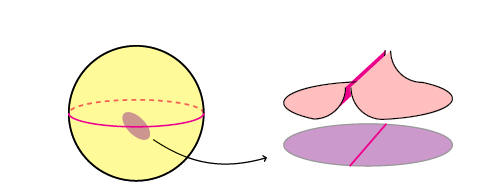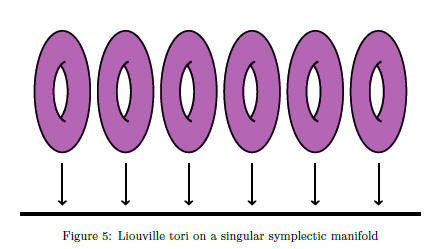Geometry and Dynamics of Singular
Symplectic Manifolds
IHP,
Paris, November-December 2017, Salle 314
This course is done in the framework of Eva
Miranda's Chaire
d'Excellence de la Fondation Sciences Mathématiques de Paris
Poster/affiche
Official webpage:
https://www.sciencesmaths-paris.fr/fr/le-cours-deva-miranda-933.htm
Annonce: Exceptionnellement, mardi 12 Décembre le cours
aura lieu à la Salle 201 de l'IHP

Summary: b-Calculus was introduced by Richard Melrose when
considering pseudodifferential operators on manifolds with boundary. Later on,
Ryszard Nest and Boris Tsygan applied these ideas to study the deformation
quantization of symplectic manifolds with boundary.
The purpose of this minicourse is to unravel the geometrical structures (b-symplectic
structures) behind this picture and describe some applications to Dynamical
systems. b-Symplectic manifolds are Poisson manifolds which are symplectic away
from an hypersurface and satisfy some transversality condition. b-Symplectic
manifolds lie "close enough" to the symplectic category and indeed their study
can be addressed using an "extended" De Rham complex. In particular many
peculiarities from Symplectic manifolds are shared with b-symplectic manifolds.
Using these ideas, we will study normal form theorems, action-angle theorems,
toric actions and applications to KAM theory. At the end of the minicourse we
present other singular symplectic structures such as folded symplectic
structures and b^m-symplectic structures (for which the transversality condition
is relaxed) and explain how they are related to b-symplectic and symplectic
structures.
We will give a general overview of the theory using some examples in celestial
mechanics as leitmotiv. For some of them (like double collision), we can even
construct b^m-symplectic structures and m-folded structures. This apparent "duality"
will be used as an excuse to closely explore the relation between the $b^m$-symplectic
category with the symplectic and folded symplectic category. This relation
depends surprisingly on the parity of m and is given by a desingularization
procedure called deblogging. Time permitting, several applications of deblogging
to dynamics and quantization will be presented.
Syllabus/Scheme of the
lectures
-
Lecture 1: Introduction. Poisson manifolds: First Examples.
-
Lecture 2: Classical examples. The language of bivector
fields. Multivector calculus and the Schouten bracket. Symplectic foliations.
-
Lecture 3: Weinstein's splitting theorem and normal forms.
Conn's linearization theorem. Poisson Cohomology computation kit.
-
Lecture 4: Poisson cohomology and integrable systems on
Poisson manifolds.
-
Lecture 5: Part I:
Proof of existence of
action-angle coordinates in Poisson Geometry. Part II:
Introduction to b-Poisson Geometry.
-
Lecture 6: Part I:
Examples in b-Poisson Geometry.
b-Darboux theorem. Modular vector fields in Poisson Geometry. Part II:
Codimension one symplectic
foliations and unimodular Poisson structures.
-
Lecture 7: Part I
Poisson Geometry of the critical
hypersurface of a b-Poisson manifold. Part II.
Changing the glasses: A dual
language for b-Poisson manifolds.
-
Lecture 8: Part I: Correction of assignments Part
II.
b-Symplectic structures. The b-complex.
Mazzeo-Melrose formula. b-Cohomology and
Poisson Cohomology.
-
Lecture 9: (Salle 201-IHP)
Part I: The
path method in b-Symplectic Geometry: Relative and global. Applications to classification
theorems in b-symplectic geometry (including
Radkos' theorem, Delzant
theorem and action-angle coordinates for $b$-symplectic manifolds)
PartII: Other singular symplectic forms. Introduction to
Deblogging: The magic stick. How to convert a $b^m$-symplectic
manifold into a (folded) symplectic one.
-
Lecture 10: Applications of Deblogging to Geometry and
Topology of b-manifolds, to Dynamics and
Quantization. Open problems (and
open problems for the Working group).

Material:
Videos of the course:
Available in the webpage of the course at FSMP:https://www.sciencesmaths-paris.fr/fr/le-cours-deva-miranda-933.htm
Bibliography:
- [BDMOP]
R. Braddell, A. Delshams, E. Miranda, C. Oms and A. Planas,
An invitation to Singular Symplectic Geometry ,
arXiv:1705.03846, accepted at International Journal of Geometric Methods in
Modern Physics, 2017.
- [CGP] A. Cannas, V. Guillemin, A.R. Pires, Symplectic Origami , International
Mathematics Research Notices, no.18, pp 4252-4293, 2011.
- [DKM] A. Delshams, A. Kiesenhofer, E. Miranda, Examples of integrable
and non-integrable systems on singular symplectic manifolds,
J. Geom. Phys.
115 (2017), 89–97.
- [DZ]
Dufour, Jean-Paul;
Zung, Nguyen Tien Poisson structures and their
normal forms.
Progress in Mathematics, 242. Birkhäuser Verlag, Basel, 2005.
xvi+321 pp. ISBN: 978-3-7643-7334-4; 3-7643-7334-2
- [DKRS] A. Delshams, V. Kaloshin, A de la Rosa, T. M.-Seara, Global
instability in the elliptic restricted three body problem, arXiv:1501.01214.
- [Du] J.J. Duistermaat, On global action-angle coordinates. Comm. Pure
Appl. Math. 33 (1980), no. 6, 687-706.
- [GMP1] V. Guillemin, E. Miranda, and A. Pires, Codimension one
symplectic foliations and regular Poisson structures. Bull. Braz. Math. Soc.
(N.S.), 42(4):607-623, 2011.
- [GMP2] V. Guillemin, E. Miranda, and A. Pires,
Symplectic and Poisson geometry on
b-manifolds. Adv. Math. 264 (2014), 864-896.
- [GMPS1] V. Guillemin, E. Miranda, A. R. Pires and G. Scott,
Toric actions on b-symplectic
manifolds, Int Math Res Notices Int Math Res Notices (2015) 2015 (14):
5818-5848.
- [GMPS2] V. Guillemin, E. Miranda, A. Pires, and G. Scott.
Convexity for Hamiltonian torus
actions on b-symplectic manifolds,
Math. Res. Lett.
24 (2017), no. 2, 363–377.
- [GMW1] V. Guillemin, E. Miranda, J. Weitsman,
Desingularizing b^m-symplectic
structures,
- [GMW2] V. Guillemin, E. Miranda, J. Weitsman, On geometric quantization
of b-symplectic manifolds ,arXiv:1608.08667.
- [LMV] C. Laurent-Gengoux, E. Miranda and P. Vanhaecke,
Action-angle coordinates for integrable systems on
Poisson manifolds.
Int. Math. Res. Not. IMRN
2011, no. 8, 1839–1869.
- [LPV]
Laurent-Gengoux, Camille;
Pichereau, Anne;
Vanhaecke, Pol Poisson structures.
Grundlehren der Mathematischen Wissenschaften [Fundamental Principles of
Mathematical Sciences], 347. Springer, Heidelberg, 2013. xxiv+461
pp. ISBN: 978-3-642-31089-8.
- [MG]R. McGehee, Singularities in classical celestial mechanics.
Proceedings of the International Congress of Mathematicians (Helsinki,
1978), pp. 827-834, Acad. Sci. Fennica, Helsinki, 1980.
- [W] A. Weinstein, The local structure of Poisson manifolds., J.
Differential Geom. 18 (1983), no. 3, 523-557.
Complementary material:
-
Albert Einstein, Zum
Quantensatz von Sommerfeld und Epstein, Deutsche Physikalische
Gesellschaft, Verhandlungen 19, 82-92 (1917), translation in Portuguese
published at Revista Brasileira de Ensino de Fisica, v. 27, n. 1, p. 103 -
107, (2005).
-
Kosmann-Schwarzbach, Yvette Les crochets de Poisson,
de la mécanique céleste à la mécanique quantique, Siméon-Denis
Poisson, 369–401,
Hist. Math. Sci. Phys., Ed. Éc. Polytech., Palaiseau, 2013.
-
Kosmann-Schwarzbach, Yvette La géométrie de Poisson,
création du XXe siècle. (French) [Poisson geometry, a twentieth-century
creation] Siméon-Denis Poisson, 129–172,
Hist. Math. Sci. Phys., Ed. Éc. Polytech., Palaiseau, 2013.
- Link to the Catalogue of the
Exhibition "Siméon-Denis Poisson Mathematics at the service of
Science" which took place in Paris and Urbana-Champaign in 2014 courtesy
of Yvette Kosmann-Schwarzbach, Version en Français ici
Catalogue merci à Yvette Kosmann-Schwarzbach.
Related activities
of the Chair:
- Working group on b-symplectic geometry and Celestial
Mechanics (every Thursday during the course from 4 to 5pm at Salle 314 at
Institut Henri Poincaré we discuss about applications of b-Symplectic
Geometry to Celestial Mechanics). We are: Roisin Braddell, Eva Miranda,
Cédric Oms, Michael Orieux, Wang Qun and anybody who wants to join. Join us!
-
Closing conference of the Chair.
-
Working group on
the n-body problem (on Mondays at Observatoire de Paris)
-
Séminaire de Géométrie Hamiltonienne (on Fridays at Jussieu).


